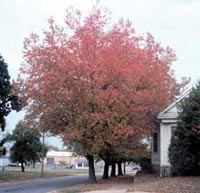Resource Library
Plant of the Week: Sweetgum
The University of Arkansas System Division of Agriculture does not promote, support or recommend plants featured in "Plant of the Week." Please consult your local Extension office for plants suitable for your region.
Plant of the Week
Sweetgum

In certain parts of the state, when I give my tree talks suggesting planting sweetgum
as a shade tree, it evokes murmurs of disapproval from the crowd. This disapproval
usually stems from painful and deep-seated childhood memories of tender feet being
punctured by sweetgum balls.
Newcomers to sweetgum country usually have tales of sweetgum balls being impossible
to compost, chew up with a lawn mower or even effectively rake up in their copious
quantity. Even the most artistically inclined amongst us can build only so many wreaths,
bowls and other crafts from the durable little balls. The state’s thriving potpourri
market seems to have scarcely dented our sweetgum ball wealth.
Yet, the sweetgum does have merit as a shade tree.
It grows quickly in heavy clay soils where more finicky trees give up and die. As
a young tree, it has an oval form and reaches 40 feet quickly. Old trees in good sites
will be three times as tall. The leaves are star shaped and the size of a ladies hand
with good fall color that tends towards the red, orange and maroon shades. Were it
not for the production of the golf ball-sized fruit, which begin appearing when the
tree is about 10 years old, the plant would make an ideal landscape tree.
The presence of an American species of sweetgum was first recorded in 1519 when Spanish
soldiers observed a ceremony between Cortez and Montezuma in which liquid-amber was
mixed with tobacco before smoking. Liquid-amber had long been known in Europe as an
incense, as base for perfumes or salves and as an herbal remedy for various ailments.
The material in European markets was from stands of the Oriental sweetgum growing
in the mountains of southern Turkey and gathered by wandering nomads.
The American sweetgum ranges from New Jersey south to Mexico mostly staying in the
low country or along streams and rivers. It is found throughout Arkansas, but probably
was introduced into the Ozark and Ouachita mountains after European settlement. It
has never been an important timber tree, being primarily used for crates and pallets.
Gum production in the US has been sporadic. During the Civil War, southern doctors
used it as a dressing for wounds and as a salve for skin ailments. In the rural South,
it was used as a substitute for chewing gum. Commercial sources for perfumery came
from the Orient. During WW II, the Taiwanese sources were cut off and Clarke County,
Ala., became the domestic source for the gum.
Young trees were tapped by wounding the bark as soon as the tree had completely leafed
out. The sap emerges as a yellowish brown liquid that slowly hardens into a rosin
in the presence of air. This rosin was scraped into buckets and carefully heated before
being strained and bottled. After the war years, the industry again moved to the Orient,
and few remember the ways of processing this sweet smelling but bitter tasting gum.
For those wishing to use the sweetgum as a landscape tree, there are three ways of
dealing with the balls.
The easiest is acceptance of the inevitable and develop a mind-set accepting the ball
much as one accepts that ticks and chiggers are a part of Arkansas summers. The second
approach is to plant a variety called the Fruitless Sweetgum which is available from
local nurseries. The final method is to use a spray in the spring which knocks off
the sweetgum balls before they develop. While spraying is a temporary fix, it is a
poor long-term solution because it must be repeated annually.
By: Gerald Klingaman, retired
Extension Horticulturist - Ornamentals
Extension News - September 1, 2000
The University of Arkansas System Division of Agriculture does not maintain lists of retail outlets where these plants can be purchased. Please check your local nursery or other retail outlets to ask about the availability of these plants for your growing area.